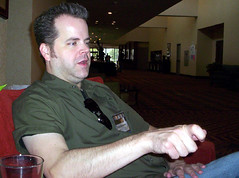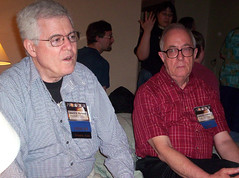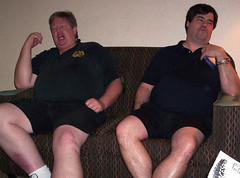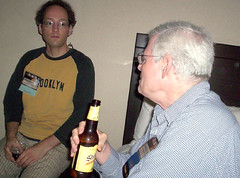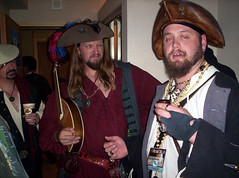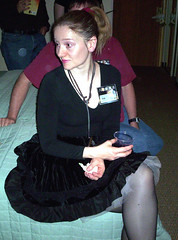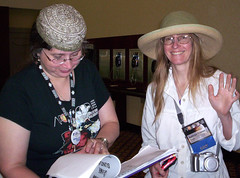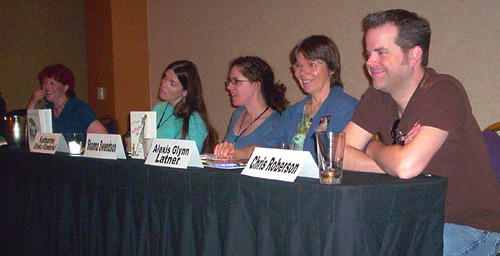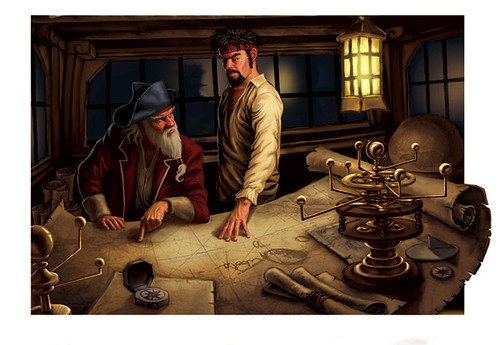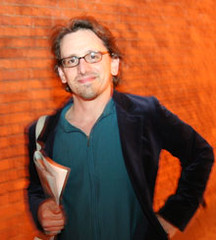When last I obsessed, the idea of finding a misused auto of a certain vintage and rehabilitating it had wheedled its way into my brain. This is a legit option when one has a brother capable of working Scotty-style engineering miracles on automotive subjects. So I started looking around my immediate environs, and was startled by the potential I discovered.
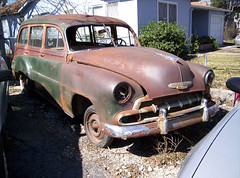
I found this old fellow tucked away in an old burger drive-in turned used car lot. It obviously scores points for being the spiritual inspiration for the current crop of PT Cruisers and HHRs traversing our nation's roads. I've had some trouble figuring out exactly what it is, though. As near as I can tell, it's either 1955 or '56 Chevy Suburban in the First Series, although it shares design elements with the GMC trucks of the era. The asking price on it was $1,200, which wouldn't be that bad except there is no engine, the insides are stripped bare and the root is utterly rusted through. It might be of use to someone already restoring one of these and needing body parts, but not at so steep a price.

This is--or at least was at one time--a 1955 Buick Riviera two door with a 127-inch wheel base. This one was found outside of San Marcos at a salvage yard, and had originated in Lockhart, right outside of Austin. The poor thing had been mangled in a wreck years before, and the owners eventually gave up on repairing it and sold it for scrap. This remains a stylish car, and I really dig those nifty ports on the sides of the front fender. For $600 or so, it's not a terrible deal, although it'd take lots of effort to restore it. The damage was very extensive. Alas, this one appeared destined for the great furnace in the sky.

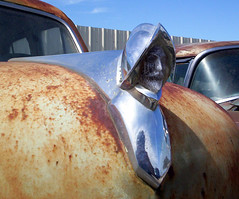
Parked right beside the Riviera was this 1950 DeSoto Deluxe two-door. I'd never actually seen a DeSoto in person before--how often are you going to find an auto named after a
conquistador in this day and age? I mean, just
look at that hood ornament! Is that not style? Oh, the wonders wrought in chrome back in the day--but that's a whole other topic entirely. Turns out that this vehicle was the apex of the DeSoto legacy--never again would DeSoto produce a car to equal the Deluxe's popularity, starting the marque on a steady decline which finally ended with Chrysler pulling the plug in 1961. This particular car had a life that outlasted its parent company by almost two decades--on the back window, peeling and yellowed with age, was a Texas A&M faculty parking permit from 1979. Structurally, the car was in good shape as well, with only slight surface rust and all glass intact. Alas, the inside was not so well-preserved. All the plastics had melted and distorted over the years, the end result being something that looked like it'd come from the queen's hive in the
Aliens movies. Someone had actually put a down payment on this one, with the express intent of turning it into a rat rod. Except that three months had passed and they hadn't paid the balance or picked up the vehicle. This one, too, looked destined for the furnace (although I was sorely tempted to make an offer for that hood ornament).
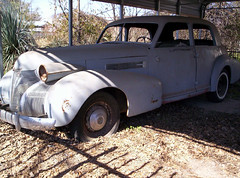
In the middle of New Braunfels I spotted this 1939 Cadillac Series 60 Special parked under a shed off one of the main thoroughfares. No engine, no headlights, the interior stripped bare and much of the glass missing, but still... there is a definite elegance about this car, even in a marginal state such as this. Although it's sitting untouched, it's not rotting, and a few phone calls revealed that it's a future restoration project for a local securities broker. I've never been that big of a Cadillac fan, but I can't fault him for his taste in cars. Of all the ones I'd found in my casual search, this was the first that really worked for me. There's something about those detached headlights that harken back to a time of roadsters and the joy of driving--when driving was a luxury few could afford.
So, 1939. Now I had an endpoint to my search, as 1939 was the last year--give or take--that most cars were produced with detached headlights. I'm not a big fan of the "rolling carriage" look from the 1920s and early '30s, nor do wooden spoke wheels get my heart pumping. So I'd narrowed my search to roughly the years of 1935-39. Maybe a Google search would turn up something where my legwork had failed. And wouldn't you know it, within minutes I'd found my dream car:
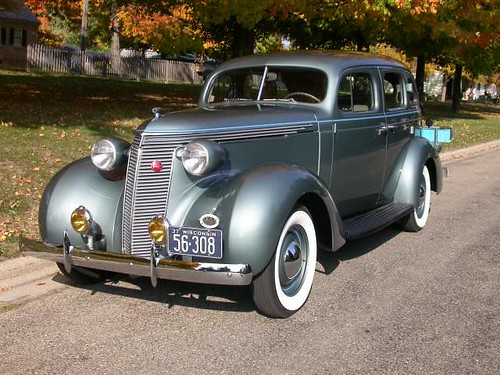
Pictured above is Jerry Daniels' restored 1937 Studebaker Dictator. I've never met Jerry, but exchanged emails with him to gush over the wonderful job he'd done in restoring that beautiful car. Need more convincing? He's got a
fantastic gallery online documenting his step-by-step process.
I never thought I'd fall in love with a Studebaker, but what's not to love about the 1937 Dictator, or it's upscale sibling, the President? The studied coolness of the winged victory grill grabbed me right away, but the flow of the fenders, the lines of the passenger cabin, running boards and the suicide doors (suicide doors!) sweetened the deal considerably. That, my friends, is a mighty pretty automobile. Imagine my delight when Jerry informed me that the famed industrial artist
Helen Dryden actually designed the vehicle. That may well make the last of the Dictators (the line name was changed to Commander in '38 because of the rise of fascism) the first auto
designed by a woman:
For both the 1937 President and Dictator Studebakers, the company contracted with Helen Dryden, a well-known Art Deco artist and industrial designer, to fashion the front grill, called the "Winged Victory" grill, and the interior. Dryden lowered the body frame 3 inches, relocated the stick shift from the column to the floor, raised the seats to living room furniture height, placed the radio speaker in the roof above the rear view mirror, and designed an understated, sleek dash board.
Lowering the car made it more accessible to women drivers. By 1937, women were a serious part of the work force in America. With well-engineered, easy-to-open doors and trunk and a comfortable interior, the Dictator line offered both families and women consumers an affordable, useful, stylish and comfortable automobile.
It's a rolling work of art, literally. The interior is cush. Everything about the car screams comfort and style, and the President echoes that call, only moreso. What's more, the demand for '37 Studebakers isn't as high as one might assume. A near-mint car will ask a price in the mid-20s--according to price guides I've consulted--whereas unrestored drivers command prices south of $10,000. A rolling chassis, sans interior or working engine lists for less than $1,000. I'd need one with the optional overdrive transmission offered back in the day if I have any hope to drive it at highway speeds, but the in-line six engine turned in amazing fuel economy for the day, a jaw-dropping 24 mpg. Considering the size of the vehicle, the cheap gas of the time and the fact that my modern PT Cruiser gets in the neighborhood of 26 mpg, that's an astonishing number. I'm sold.
So, now I have a plan: Find a decent, but not pristine '37 Dictator or President for less than $10,000. Work with my brother to restore it and upgrade safety features (vintage car purists may hate me for this, but seat belts are a necessity. Sorry guys). Fine-tune the engine (if original) to maximize the fuel economy, or replace with modern engine if the original is lost or beyond repair. Fuel economy is important, you know, with gasoline prices hovering around $3 a gallon with prices only expected to increase over the next decade. The more I think of it, the more that 24 mpg looks good for 1937, but pales in comparison to the 50 mpg turned in by the hybrid Prius and the like. The Prius design leaves me cold (when, oh when will the Japanese develop some flair?) but I like those fuel numbers. If only there were something I could do to upgrade my future Studebaker...

